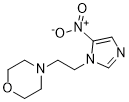Nimorazole,a nitroimidazole anti-infective, is a hypoxic radiosensitizer potentially useful in the treatment of patients with head and neck squamous cell carcinoma (HNSCC). Nimorazole significantly improves the effect of radiotherapeutic management of supraglottic and pharynx tumors and can be given without major side-effects. Nimorazole is the only such chemical reagent that has shown a significant effect in a randomized controlled trial in head and neck cancer.
Physicochemical Properties
| Molecular Formula | C9H14N4O3 | |
| Molecular Weight | 226.23 | |
| Exact Mass | 226.106 | |
| Elemental Analysis | C, 47.78; H, 6.24; N, 24.77; O, 21.22 | |
| CAS # | 6506-37-2 | |
| Related CAS # | 94107-55-8 (HCl);6506-37-2; | |
| PubChem CID | 23009 | |
| Appearance | Light yellow solid powder | |
| Density | 1.4±0.1 g/cm3 | |
| Boiling Point | 443.0±35.0 °C at 760 mmHg | |
| Flash Point | 221.7±25.9 °C | |
| Vapour Pressure | 0.0±1.1 mmHg at 25°C | |
| Index of Refraction | 1.637 | |
| LogP | -0.08 | |
| Hydrogen Bond Donor Count | 0 | |
| Hydrogen Bond Acceptor Count | 5 | |
| Rotatable Bond Count | 3 | |
| Heavy Atom Count | 16 | |
| Complexity | 239 | |
| Defined Atom Stereocenter Count | 0 | |
| SMILES | O1C([H])([H])C([H])([H])N(C([H])([H])C1([H])[H])C([H])([H])C([H])([H])N1C([H])=NC([H])=C1[N+](=O)[O-] |
|
| InChi Key | MDJFHRLTPRPZLY-UHFFFAOYSA-N | |
| InChi Code | InChI=1S/C9H14N4O3/c14-13(15)9-7-10-8-12(9)2-1-11-3-5-16-6-4-11/h7-8H,1-6H2 | |
| Chemical Name | 4-[2-(5-nitroimidazol-1-yl)ethyl]morpholine | |
| Synonyms |
|
|
| HS Tariff Code | 2934.99.9001 | |
| Storage |
Powder-20°C 3 years 4°C 2 years In solvent -80°C 6 months -20°C 1 month |
|
| Shipping Condition | Room temperature (This product is stable at ambient temperature for a few days during ordinary shipping and time spent in Customs) |
Biological Activity
| ln Vitro |
|
||
| ln Vivo |
|
||
| Animal Protocol |
|
||
| References | Radiother Oncol.2003 Jan;66(1):65-70. | ||
| Additional Infomation |
Nimorazole is a member of imidazoles and a C-nitro compound. Nimorazole has been used in trials studying the treatment of Hypoxia, Radiotherapy, Hypoxic Modification, Gene Profile, Gene Signature, and Head and Neck Squamous Cell Carcinoma, among others. Nimorazole is a water soluble, 5-nitroimidazole compound with antibacterial and potential radiosensitizing activity. As an oxygen mimetic, nimorazole induces free radical formation and is able to sensitize hypoxic cells to the cytotoxic effects of ionizing radiation. This prevents DNA repair and thus enhances damage to DNA strands; eventually, leading to tumor cell death. Nimorazole is less active but also less toxic than the 2-nitroimidazole compounds, misonidazole and etanidazole. An antitrichomonal agent which is effective either topically or orally and whose urinary metabolites are also trichomonicidal. |
Solubility Data
| Solubility (In Vitro) | DMSO : 33.33 ~45 mg/mL ( 147.33 ~198.91 mM) |
| Solubility (In Vivo) |
Solubility in Formulation 1: ≥ 2.08 mg/mL (9.19 mM) (saturation unknown) in 10% DMSO + 40% PEG300 + 5% Tween80 + 45% Saline (add these co-solvents sequentially from left to right, and one by one), clear solution. For example, if 1 mL of working solution is to be prepared, you can add 100 μL of 20.8 mg/mL clear DMSO stock solution to 400 μL PEG300 and mix evenly; then add 50 μL Tween-80 to the above solution and mix evenly; then add 450 μL normal saline to adjust the volume to 1 mL. Preparation of saline: Dissolve 0.9 g of sodium chloride in 100 mL ddH₂ O to obtain a clear solution. Solubility in Formulation 2: ≥ 2.08 mg/mL (9.19 mM) (saturation unknown) in 10% DMSO + 90% (20% SBE-β-CD in Saline) (add these co-solvents sequentially from left to right, and one by one), clear solution. For example, if 1 mL of working solution is to be prepared, you can add 100 μL of 20.8 mg/mL clear DMSO stock solution to 900 μL of 20% SBE-β-CD physiological saline solution and mix evenly. Preparation of 20% SBE-β-CD in Saline (4°C,1 week): Dissolve 2 g SBE-β-CD in 10 mL saline to obtain a clear solution. Solubility in Formulation 3: ≥ 2.08 mg/mL (9.19 mM) (saturation unknown) in 10% DMSO + 90% Corn Oil (add these co-solvents sequentially from left to right, and one by one), clear solution. For example, if 1 mL of working solution is to be prepared, you can add 100 μL of 20.8 mg/mL clear DMSO stock solution to 900 μL of corn oil and mix evenly. Solubility in Formulation 4: 10% DMSO+40% PEG300+5% Tween-80+45% Saline: ≥ 2.08 mg/mL (9.19 mM) (Please use freshly prepared in vivo formulations for optimal results.) |
| Preparing Stock Solutions | 1 mg | 5 mg | 10 mg | |
| 1 mM | 4.4203 mL | 22.1014 mL | 44.2028 mL | |
| 5 mM | 0.8841 mL | 4.4203 mL | 8.8406 mL | |
| 10 mM | 0.4420 mL | 2.2101 mL | 4.4203 mL |
